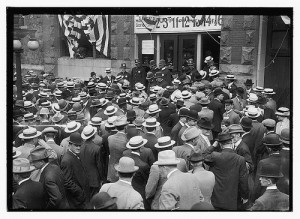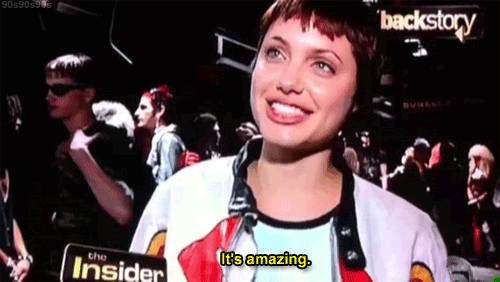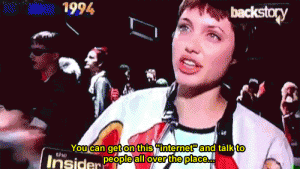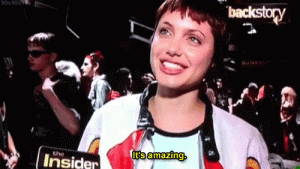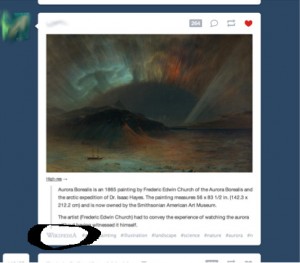Month: April 2013
AAA 2013: DANG, that’s necessary conflict
Conflict is uncomfortable… yet necessary, at least in the case of my research and submission to the Digital Anthropology group, DANG, panel for the American Anthropological Association (AAA) 2013 meeting. In Chicago this year, I’m hoping to share my findings about the ways in which a fandom encounters and uses conflict between members to refine the values they espouse.
“It boils down to respect”:
Defining the values of a fandom through conflict online
Increasingly, social media allows users to connect their online behaviors to physical practices in pursuit of collective goals. In these digital public spaces, communities of practice are able to bypass geographic and temporal boundaries. For U.S. Women National soccer team (USWNT) fans, Tumblr offers a digital realm in which multimodal communication unfolds – and quite often, conflict arises. Through online ethnography and discourse analysis, this study examines conflict as essential to refining USWNT fandom values; however, conflict also jeopardizes the participatory practices that define the fandom.
This community of practice can be explored as a collaborative project that incorporates wider discourses of gender, sport, and nation. USWNT fans share media from first-hand experiences, as well as produce user-generated content. Fan-users also broadcast requests to the fandom, display insider knowledge, and articulate meaning in belonging to the fandom. Subjects spurring USWNT fandom conflict include source attribution and rules for appropriately tagging content. Frustrations about these points of conflict threaten archiving and sharing habits, which in turn threaten to dry one data stream through which “fandom” knowledge is quenched.
Considering the future of open access and linked communities, the current justifications fan-users apply toward the perceptions of ethical responsibilities in the fandom may be instructive. This paper also considers methodological and ethical challenges in researching asynchronous communication in a dynamic digital space. The ways in which the USWNT fandom “does” conflict may offer insight into the ways digitally mediated behaviors could inform practices and discursive spaces of future engagements and conflict resolution.
Summary: 3 Features in Successful Cultural Heritage Outreach Events

The following reflections summarize features of cultural heritage outreach and engagement events I have attended during my recent fieldwork at the Smithsonian Institution. I have selected three overlapping features that appear to have contributed to the success of these cultural heritage events; in an upcoming post, I will also offer several tips for improving upon these outreach strategies.
Crowdsourcing
[Gathering or requestion information and action from the crowd, audience, or user]These engagement events have been predominately in line with a citizen-scientist model or crowdsourcing model. In other words, they have gathered participation on an avocational and/or volunteer basis. They have also operated in systematic ways to collect, refine, populate, and assign values – “doing things” with materials. The events have not necessarily been science-focused, though some have been. Most have required participants to BYOD and register for participation. Several of the events have also gathered experiential information and viewpoints from participants at the close of the event.
Participatory
[Audiences or individuals “opting in” toward a goal, either personal or collective]These outreach events have been based around the idea of a shared experience of working toward a project goal – calling upon a sense of participatory culture or being creator-consumers. That means that participants have been taking actions (“doing”) toward both individual projects and shared roles or group work toward parts of a goal, whilethe event has taken participants toward achieving a collective goal in the end.
Free but exclusive
[No charge but cost of time and some bounding on event]Each of these events were held by cultural heritage institutions and were free to attend; yet, the events were also managed in a way that was bounded in number, space, or access. Clarifying my use of “exclusive” to mean selective in this context, the events have typically accepted the first candidates for participation and allowed those individuals to feel as though they are gaining unique access in some way.
The three features discussed above appear to have subtly informed approaches and agenda; and resulted in events that appeared to be reasonably successful.* Enthusiastic and engaged participants were found at all events and activities taken toward each event’s stated goals.
Despite the appearances of success for these events, each event offered several points at which engagement or efficiency could be improved. Watch this space for an upcoming post that speaks to four ways best practice at cultural heritage outreach events can be built.
*This assumption made without knowledge of each event’s stated metrics for success.
**Image of crowds outside the entrance of the 1912 Republican National Convention held at the Chicago Coliseum, Chicago, Illinois, June 18-22, 1912 – shared from George Grantham Bain Collection (Library of Congress) – via Flickr Commons
Acknowledging the magic of digital communication, c. 1994
Webs of Knowledge in Action IRL
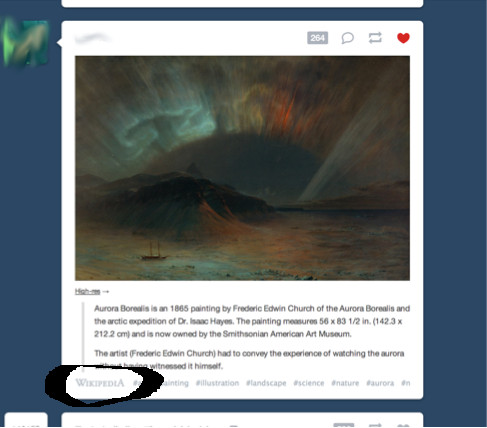
Last week, I was privy to an amazing experience – I saw webs of knowledge unfold across digital space and found my researching realms overlapping. Webs of knowledge in action – in real life (IRL)!
Backstory: In February, I participated in a Smithsonian American Art Museum-hosted Wikipedia edit-a-thon focusing on Civil War landscape art. At the beginning of the event, we had a dynamic tour of the Civil War and American Art exhibit by curator Eleanor J. Harvey and learned about the integration of moments of conflict in landscape art in 19th century America. We closed the tour with a discussion of an 1865 painting by Frederic Edwin Church called “Aurora Borealis.” The piece is stunning in person and I took on the challenge of creating a new Wikipedia article about Aurora Borealis (painting). I returned to the article several times and continue to flesh it out – incidentally, I welcome anyone else to contribute to the article with content, editing, or relating the piece to other works.
Last week, while scrolling on Tumblr, I noticed the following post by a blog I follow:
Upon seeing this post in my feed, I mused, “I really love that image – that is such a great painting” –
Then, however, I noticed that the post cited Wikipedia as the source (see circled component in the image above).
THEN, I realized… “golly, that’s MY article – I created that article and here it is being promoted, shared, liked, and reblogged by Tumblr users”
This is a fascinating example of cultural heritage content held at a museum being linked (literally) in a central and open access knowledge repository, then accessed and shared in a social networking space: overlapping forms of digital communication.
This was a social share of Smithsonian content; by way of an outreach and engagement event that sought to share Smithsonian collections by explaining their context and content through (or on) Wikipedia. Then that content was taken up by a user on a social media network and shared with his followers. Then his followers responded to that content by liking and reblogging and replying to the content. This Smithsonian-housed content was, therefore, literally linked to broader scientific debates via @ikenbot’s page and the Tumblr/social media sharing loop.
Also, as a leader in the science Tumblr section, @ikenbot’s decision to reference the Wikipedia article adds authority or credit to the validity of Wikipedia within that particular community of practice on Tumblr (science-focused bloggers).
The original post: http://ikenbot.tumblr.com/post/48160589544/aurora-borealis-is-an-1865-painting-by-frederic
Is this a case of “If you build it, they will share…”? Perhaps not, yet this instance is a powerfully persuasive example, even as a one-off. It demonstrates the realities of sourcing and sharing content in digital spaces; furthermore, it is a testament to the ways Smithsonian Institution and Wikipedia content meshes and unfolds across digital space through social and cultural behaviors in digital spaces. Plus, it was quite cool to have my own words cited and sourced as a part of the summarization of the image.
Finally, if you have time and are in the DC area, please do visit the Civil War and American Art exhibit; and hurry! The exhibit closes April 28, 2013 and moves to MoMA in NYC in May through September. More information is available through the link, including podcasts and exhibit guides.
Reddit: Cautions and Challenges in Crowdsourcing
Neal Ungerleider (@nealunger on Twitter) writes for Fast Company about Redditors’ efforts in sleuthing crowdsourced information on the Boston Marathon bombing suspects in the attached link. Notable is Ungerleider’s cautious balance in critiquing the motivations of participants and the utility of crowdsourcing information at an event.
In exploring the behavior on this subreddit, a pertinent takeaway from this situation emerges: crowdsourcing in investigative situations is best for gathering data (that can be used by analysts to offset more specific intelligence) but becomes unreliable and even dangerous as misinformation if participants are given space to assert conclusions.
Conversely, crowdsourced data, coupled with conclusions, can be helpful for cultural heritage projects like the ones on which I am working; in these situations, we may have serendipitous moments of discovery in relation to collections and the hidden stories of our archives. In both cases, the cautions of the Reddit case are useful considerations in understanding and relating to users/audiences.

